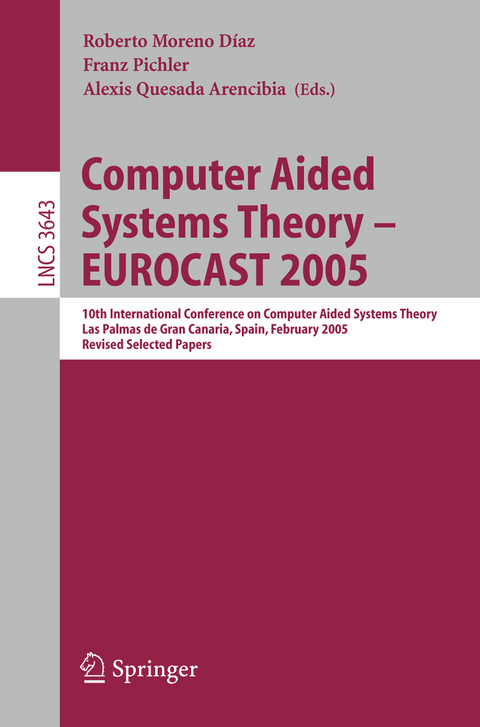
Computer Aided Systems Theory – EUROCAST 2005
Springer Berlin (Verlag)
978-3-540-29002-5 (ISBN)
Formal Approaches in Modelling.- On the Physical Formal and Semantic Frontiers Between Human Knowing and Machine Knowing.- Approximation Problems Categories.- Computation of Partial Automata Through Span Composition.- Degenerate Arrays: A Framework for Uncertain Data Tables.- Neural Network Sensitivity Analysis Applied for the Reduction of the Sensor Matrix.- Fuzzy Modeling for Coal Seams A Case Study for a Hard-Coal Mine.- Optimization of a Class of Uncertain Systems Based on Uncertain Variables.- Computational Simulation of Categorical Constructions.- Composing Transitions into Transactions in UML Diagrams.- Theory-Building with System Dynamics: Principles and Practices.- Ontology Integration for Statistical Information.- Intelligent Information Systems.- On Recursive Functions and Well-Founded Relations in the Calculus of Constructions.- Longest Sorted Sequence Algorithm for Parallel Text Alignment.- Information Retrieval and Large Text Structured Corpora.- Meteorological Image Descriptors.- Towards a Certified and Efficient Computing of Gröbner Bases.- CheapTB: A Low Cost of Operation Distributed Filesystem.- Spelling Correction on Technical Documents.- Verification of Language Based Fault-Tolerance.- Applying Stacking and Corpus Transformation to a Chunking Task.- Extracting Computer Algebra Programs from Statements.- Integrating Syntactic Information by Means of Data Fusion Techniques.- Unsupervised Learning in Information Retrieval Using NOW Architectures.- An Iterative Method for Mining Frequent Temporal Patterns.- Information Applications Components.- Data Mining with Scatter Search.- Web Usage Mining Project for Improving Web-Based Learning Sites.- Similarity Queries in Data Bases Using Metric Distances - from Modeling Semantics to Its Maintenance.- AWEB-CASE Tool Prototype for Hybrid Software Development.- An Augmentative Communication System Based on Adaptive Evolutionary Hypermedia Systems.- The Gaps of the Thesaurus Wordnet Used in Information Retrieval.- Fuzzy Adaptive Objects (Logic of Monitors).- A Model-Based Architecture for Fuzzy Temporal Diagnosis.- Extension of Ontologies Assisted by Automated Reasoning Systems.- A Software Architecture for Effective Document Identifier Reassignment.- An Ontology for Reusing Synthetic Tasks.- A Tractable Subclass of Fuzzy Constraint Networks.- Parallel State Space Generation and Exploration on Shared-Memory Architectures.- Towards Automated Controlling of Human Projectworking Based on Multiagent Systems.- Cryptography and Spectral Analysis.- Tree-Structured Legendre Multi-wavelets.- Remarks on Calculation of Autocorrelation on Finite Dyadic Groups by Local Transformations of Decision Diagrams.- A New Pseudo-Random Generator Based on Gollmann Cascades of Baker-Register-Machines.- An Excellent Permutation Operator for Cryptographic Applications.- Fault Cryptanalysis of ElGamal Signature Scheme.- Complexity-Theoretical Approaches to the Design and Analysis of Cryptographical Boolean Functions.- Algorithm for Proving the Knowledge of an Independent Vertex Set.- Improvement of the Edit Distance Attack to Clock-Controlled LFSR-Based Stream Ciphers.- Protocol Analysis for Concrete Environments.- Computer Vision.- Pattern Recognition in AVHRR Images by Means of Hibryd and Neuro-fuzzy Systems.- Image Processing Techniques for Braille Writing Recognition.- Retinal Based Authentication via Distributed Web Application.- Skeleton Extraction of 2D Objects Using Shock Wavefront Detection.- Cue Combination for Robust Real-Time Multiple Face Detection at Different Resolutions.-Evolutionary Color Constancy Algorithm Based on the Gamut Mapping Paradigm.- Vision Based Automatic Occupant Classification and Pose Recognition for Smart Airbag Deployment.- Biocomputing.- A Wiener Neuronal Model with Refractoriness.- On Myosin II Dynamics: From a Pulsating Ratchet to a Washboard Potential.- Feedback Effects in Simulated Stein's Coupled Neurons.- Upcrossing First Passage Times for Correlated Gaussian Processes.- Convergence of Iterations.- Semiautomatic Snake-Based Segmentation of Solid Breast Nodules on Ultrasonography.- Parallel Progressive Multiple Sequence Alignment.- Concepts and Systems Tools for Modelling Signal Processing in Vertebrate Retina.- Application of Multichannel Vision Concepts and Mechanisms in an Artificial Industrial Vision System.- Intelligent Vehicular Sytems.- Soft Computing and Geometrical Control for Computer Aided Driving.- A Monocular Solution to Vision-Based ACC in Road Vehicles.- Multi-objective Dynamic Optimization for Automatic Parallel Parking.- Electric Power Steering Automation for Autonomous Driving.- Computer Vision Application: Real Time Smart Traffic Light.- Permanency Memories in Scene Depth Analysis.- Pedestrian Detection for Intelligent Vehicles Based on Active Contour Models and Stereo Vision.- Fast Road Sign Detection Using Hough Transform for Assisted Driving of Road Vehicles.- Robotic Soccer, Robotics and Control.- Advances in Robotics.- Current and Future Trends and Challenges in Robot Soccer.- Strategy and Communication in Robotic Soccer Game.- Rete Algorithm Applied to Robotic Soccer.- Towards a Biomathematical Model of Intentional Autonomous Multiagent Systems.- A Controller Network for a Humanoid Robot.- Programming by Integration in Robotics.- A Mathematical Formalism for the Evaluation of C-Spacefor Redundant Robots.- Global Modal Logics for Multiagent Systems: A Logical Fibering Approach.- Improved Non-standard Discretization Methods for Nonlinear Dynamical Control Systems.- Hierarchical Control of a Distributed Solar Collector Field.- Explanatory Analysis of Data from a Distributed Solar Collector Field.
| Erscheint lt. Verlag | 22.9.2005 |
|---|---|
| Reihe/Serie | Lecture Notes in Computer Science | Theoretical Computer Science and General Issues |
| Zusatzinfo | XIV, 634 p. |
| Verlagsort | Berlin |
| Sprache | englisch |
| Maße | 155 x 235 mm |
| Gewicht | 959 g |
| Themenwelt | Informatik ► Weitere Themen ► CAD-Programme |
| Schlagworte | Automata • automated reasoning • Automation • Autonomous Systems • Biocomputing • CASE • Cognition • Complex Systems • Computer aided system theory • computer vision • formal methods • Hybrid Systems • Image Processing • information system • Information Theory • intelligent control systems • Intelligent Vehicles • Modeling • neuro • Neuroinformatics • Optimization • pattern recognition • Reactive Systems • Robotics • Robot Soccer • Searching • Simulation |
| ISBN-10 | 3-540-29002-8 / 3540290028 |
| ISBN-13 | 978-3-540-29002-5 / 9783540290025 |
| Zustand | Neuware |
| Haben Sie eine Frage zum Produkt? |
aus dem Bereich


